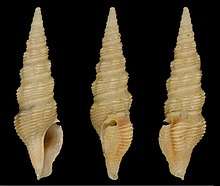Compsodrillia acestra
Compsodrillia acestra is a species of sea snail, a marine gastropod mollusc in the family Pseudomelatomidae, the turrids and allies.[1]
| Compsodrillia acestra | |
|---|---|
 | |
| Original image of a shell of Compsodrillia acestra | |
| Scientific classification | |
| Kingdom: | Animalia |
| Phylum: | Mollusca |
| Class: | Gastropoda |
| Clade: | Caenogastropoda |
| Clade: | Hypsogastropoda |
| Clade: | Neogastropoda |
| Superfamily: | Conoidea |
| Family: | Pseudomelatomidae |
| Genus: | Compsodrillia |
| Species: | C. acestra |
| Binomial name | |
| Compsodrillia acestra (Dall, 1889) | |
| Synonyms[1] | |
| |
Description
The length of the shell attains 19 mm, its diameter 5.5 mm.
(Original description) The shell is long and slender. It has a pale olive-color with a translucent white tip. It contains 9 whorls, with a smooth vitreous rounded two-whorled protoconch. The fasciole is wide, steep, excavated and marked with close-set fine even spirals.;It is bounded behind by a sharply cut elevated thread, a little space in front of the suture. The whorl in front of the fasciole is covered with close-set, strong, subequal, flattish spirals, with narrow channelled interspaces. These spirals, from two on the four apical whorls, increase to seven on the penultimate whorl, and eleven (behind those on the siphonal canal) on the body whorl. Here they are a little more widely separated, and have one or two intercalary fine threads in the interspaces. On the siphonal canal there are six primary threads alternating with somewhat smaller secondary ones. The transverse sculpture consists of gently elevated ribs (eight on the penultimate whorl), which vary in different specimens as to elevation and strength. In the type specimen figured they begin at the fasciole and fade on the base. The varix is strong and protrudes. There is a touch of livid color in front of it, which is seen nowhere else on the shell. The aperture is whitish. The throat is slightly livid, not lirate. The notch is deep and strong. The outer lip is thin, contracted for the siphonal canal. The inner lip shows a thin elevated callus. The columella is straight. The siphonal canal is rather short, and recurved. [2]
Distribution
C. acestra can be found off the Florida Keys, in the Gulf of Mexico, off the coast of Eastern Brazil.[3]
References
- Compsodrillia acestra (Dall, 1889). Retrieved through: World Register of Marine Species on 5 April 2010.
- Bulletin of the Museum of Comparative Zoology at Harvard College vol. 18 (1889)

- Tunnell, John W., Jr., Felder, Darryl L., & Earle, Sylvia A., eds. Gulf of Mexico Origin, Waters, and Biota, Volume 1: Biodiversity. Texas A&M University Press, 2009. 669.
- Absalão, R. S.; Pimenta, A. D. & Caetano, C. H. S. 2007. Turridae (Mollusca, Neogastropoda, Conoidea) coletados no litoral sudeste do Brasil, Programa REVIZEE “Score” Central. Biociências (On-line) 13: 19-47
External links

- Tucker, J.K. (2004). "Catalog of recent and fossil turrids (Mollusca: Gastropoda)" (PDF). Zootaxa. 682: 1–1295.
- Rosenberg, G.; Moretzsohn, F.; García, E. F. (2009). Gastropoda (Mollusca) of the Gulf of Mexico, Pp. 579–699 in: Felder, D.L. and D.K. Camp (eds.), Gulf of Mexico–Origins, Waters, and Biota. Texas A&M Press, College Station, Texas
| Wikimedia Commons has media related to Compsodrillia acestra. |